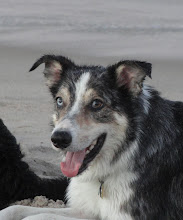Acknowledging Limitations
I'll tell you a secret. I'm a Dr. Phil fan. On the rare occasions when I am home at 3:00 in the afternoon, I usually watch his show. He has a particular catchphrase that I particularly appreciate: "You can't change what you don't acknowledge".
My dogs, particularly Speedy and Dean, have taught me this same lesson over and over. Acknowledging limitation is not negativity. Honestly recognizing a dog's weaknesses, in addition to his or her strengths, does not somehow squash the dog's potential to learn and grow. And taking difficulties into account when making training and performance decisions does not set the team up for failure. In fact, I would say the exactly opposite: Acknowledging limitation, being honest about a dog's weaknesses, and taking difficulties into account when making training and performance decisions can actually set the team up for the greatest possible success!
You can't change what you don't acknowledge. And - even more important . . . what you acknowledge can be changed, or, in cases where something really cannot be changed, dealt with in a proactive way.
A very long time ago, just as Speedy and I were getting involved with the sport of Canine Musical Freestyle, he was dealing with a somewhat serious fear of German Shepherds. At that time I had completely bought in to the idea that I had to push him to do what he had been trained to do, in spite of the proximity of Shepherds, so he would "get over" the fear. I was armed with techniques like acting confident so Speedy would, supposedly, see that I was not worried and decide that he didn't need to either; or, visualizing him performing perfectly in those situations so he would live out what I had visualized.
It never even occurred to me at that point that it might be beneficial, much less necessary, to consider Speedy himself. It all came to a boil at a Rally trial where he was crated near a barking Shepherd. I could have crated him out of the car, or moved him away from the Shepherd, but instead I made him "tough it out" in the crate so he would see that there was absolutely nothing to worry about.
The next day at Rally class, he melted down completely. All of the work that I had done with him on confidence building and trust evaporated completely. He didn't recover. Over several weeks I tried going back to the basics of trust and confidence building with him, but he would have none of it.
That was when we changed over to a Freestyle class. He spent the first couple classes hiding behind the soda cooler. Finally, I gave up. I told him, actually out loud, that I would not push him anymore, that he was going to be allowed to be himself, and that I would not make him do anything he was afraid to do again. He immediately got up, and came out from behind the cooler. By the end of that class, we were doing simple Freestyle moves on the sidelines. Within a couple of weeks, he was working on the floor with the dogs.
What changed? I did. Instead of trying to pretend that Speedy was something that he could actually never be, I acknowledged his fear. And when I made that decision I was equipped, finally, to start helping Speedy in real ways.
One of the proudest days of our performance career was the day he danced in front of 500 people and loved every minute of it! After we finished, they thundered applause, and for just a split second he looked startled, and then his eyes softened, and he looked around, and pleasure beamed forth from him. He only got that far because I made the choice to be honest about his limitations.
We spun our wheels for a long time until I got to the point where I had to acknowledge the serious problem that Dean had that was not going to vanish as a result of training. When I did that the door opened for me to learn how I could help Dean cope with the problem.
Dean was able to enjoy Agility class for years (he spent his downtime in the car with Through a Dog's Ear playing so he could not hear other dogs slam the teeter!), and he went on to earn titles in Rally, Freestyle, Rally FrEe, Tricks, and Agility. Most important of all, because I got to the point where I honestly recognized what Dean was dealing with, I was able to take steps to give him an excellent overall quality of life.
And I have come to appreciate Dean fully for who he is. He is not defined by anxiety or noise phobia, but those will always be a part of him. I have a lot of respect for my soft, sweet, goofy boy who has become strong and resilient over the years as he has learned to live beautifully, in spite of those problems.
Because of these lessons, I do not consider making direct and honest statements that acknowledge issues or problems or difficulties or limitations to be taboo! I will boldly say that Dean is noise phobic, that Tessa is skittish about being touched by anyone but me, that Tessa struggles with the concept of verbal cues, that Dean gets extremely nervous if he is asked to perform in front of a live audience, etc.
It is my firm belief that willingness to acknowledge these sorts of things creates an opportunity to move forward and unlock the dog's real potential.



